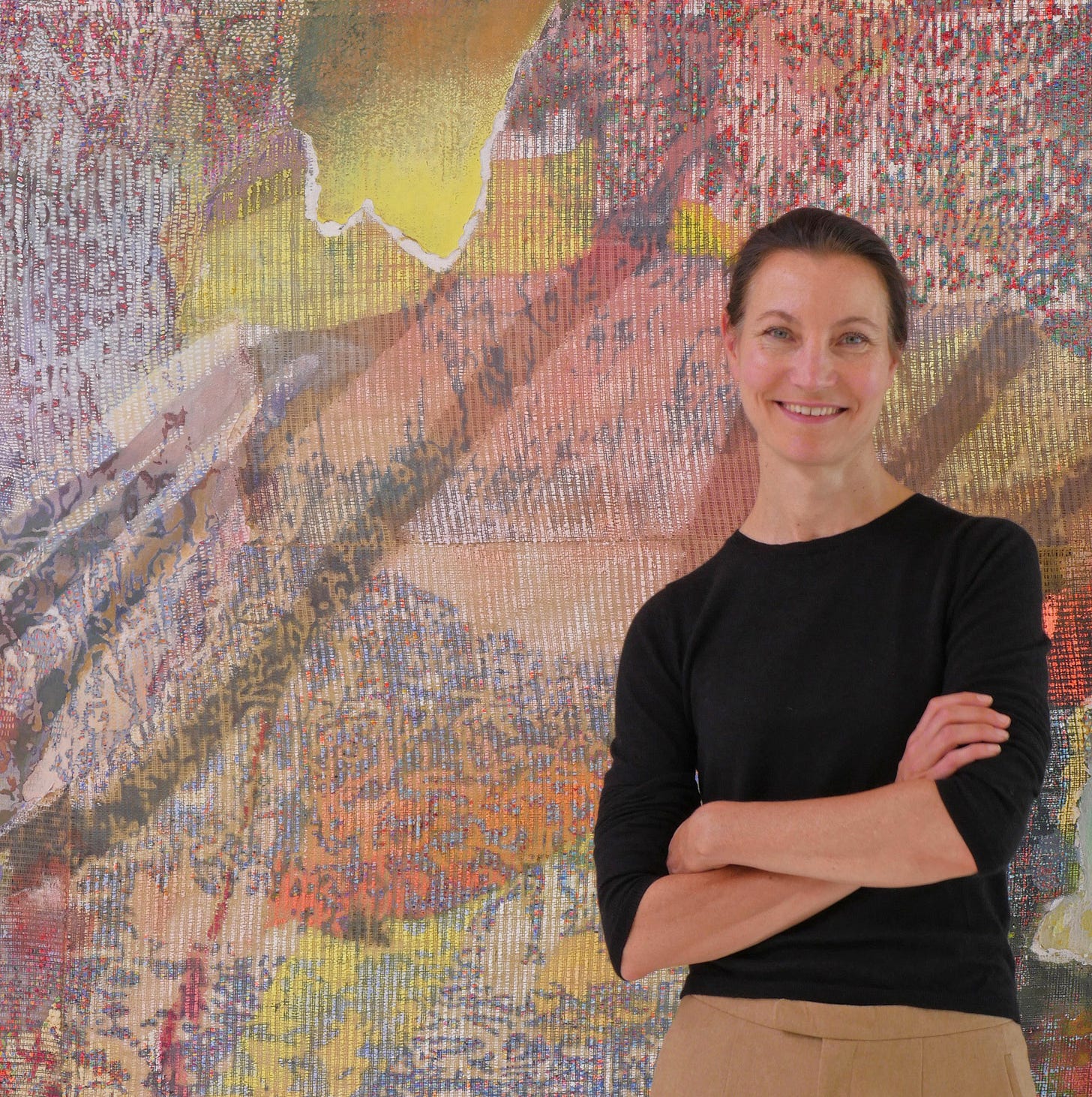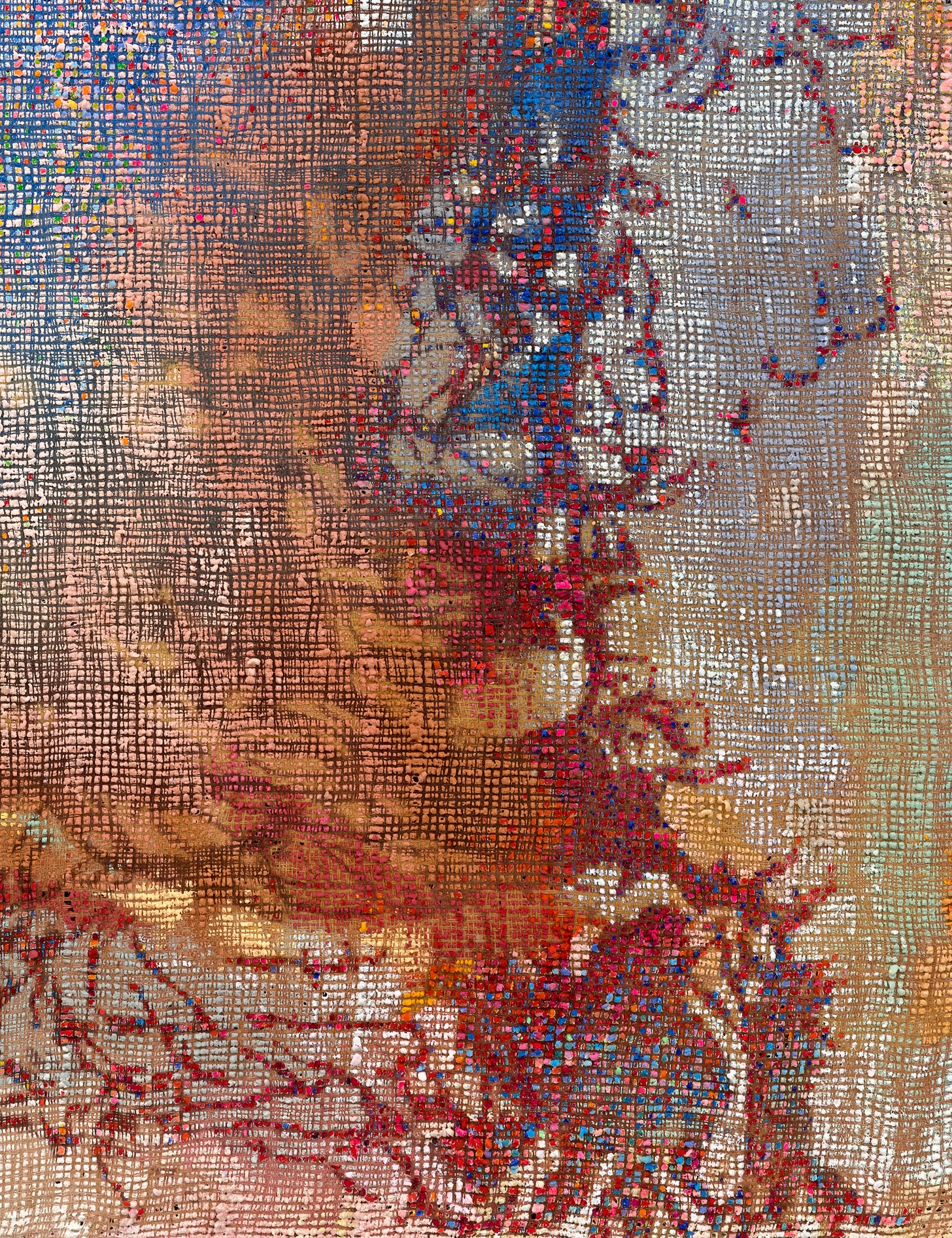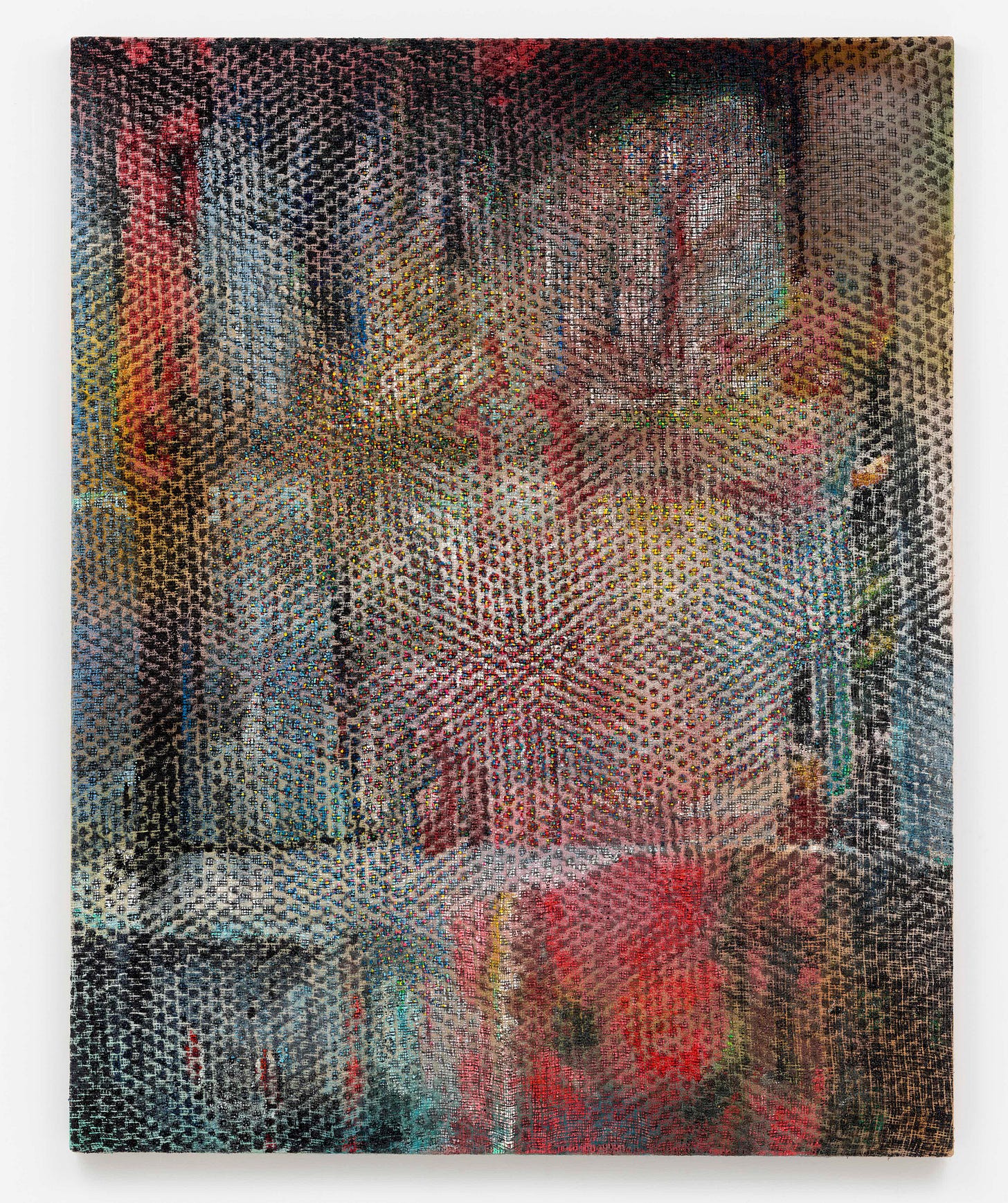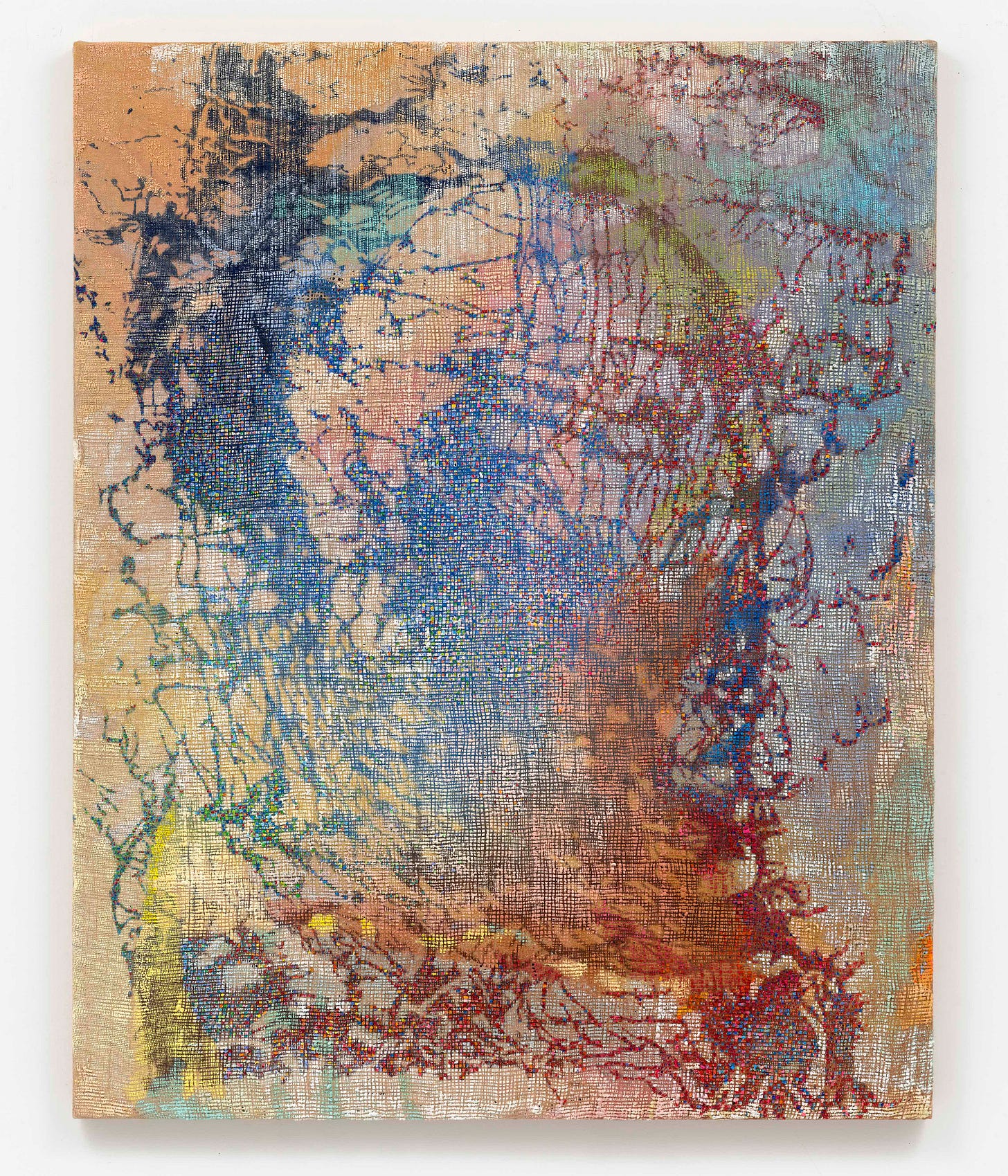It’s not often I discover an artist with a process that’s genuinely new to me. These days I rarely look at a painting completely puzzled, scratching my head, having no clue how the artist made it. Jutta Haeckel was one of those artists.
But before we get to Jutta’s unorthodox painting methods, there’s the work itself. Her paintings have a beautifully decayed aesthetic that makes the marks look as if they’re growing out of the fabric. The work is ambiguous yet intricate, with occasional grids emerging, and even recognisable forms from nature that get buried in her process. The work appears loose and ethereal, with swirling organic patterns, but at the same it’s rigorous and structured.
My first thought was that Jutta’s paintings were made using some sort of chemical reaction in the paint, but it turns out she achieves her effects from painting on both sides of a jute fabric, which she also pulls threads from in order to make it extra porous. There is, of course, more to her process than that, but I don’t want to butcher her intriguing technique so I’ll let her go into the details.
Jutta, who is Düsseldorf based, spoke to me on the eve of her solo show ‘Skin in the Game’, which recently opened at Hosfelt Gallery in San Francisco, and runs till March 15th.
Hey Jutta. The first thing I wanted to ask about is your painting process. Can you explain how you start a piece? Are you painting on the reverse side of the canvas?
When painting, I put my working materials under a certain amount of stress and try to push them to new limits.
The first step mostly is to thin out and accentuate the network of jute. By pulling out threads, each fabric is given its own inner structure, which is sometimes denser, sometimes very loose, that you can even see through the mesh. This new rhythm of the threads has a lasting influence on the subsequent pictorial process.
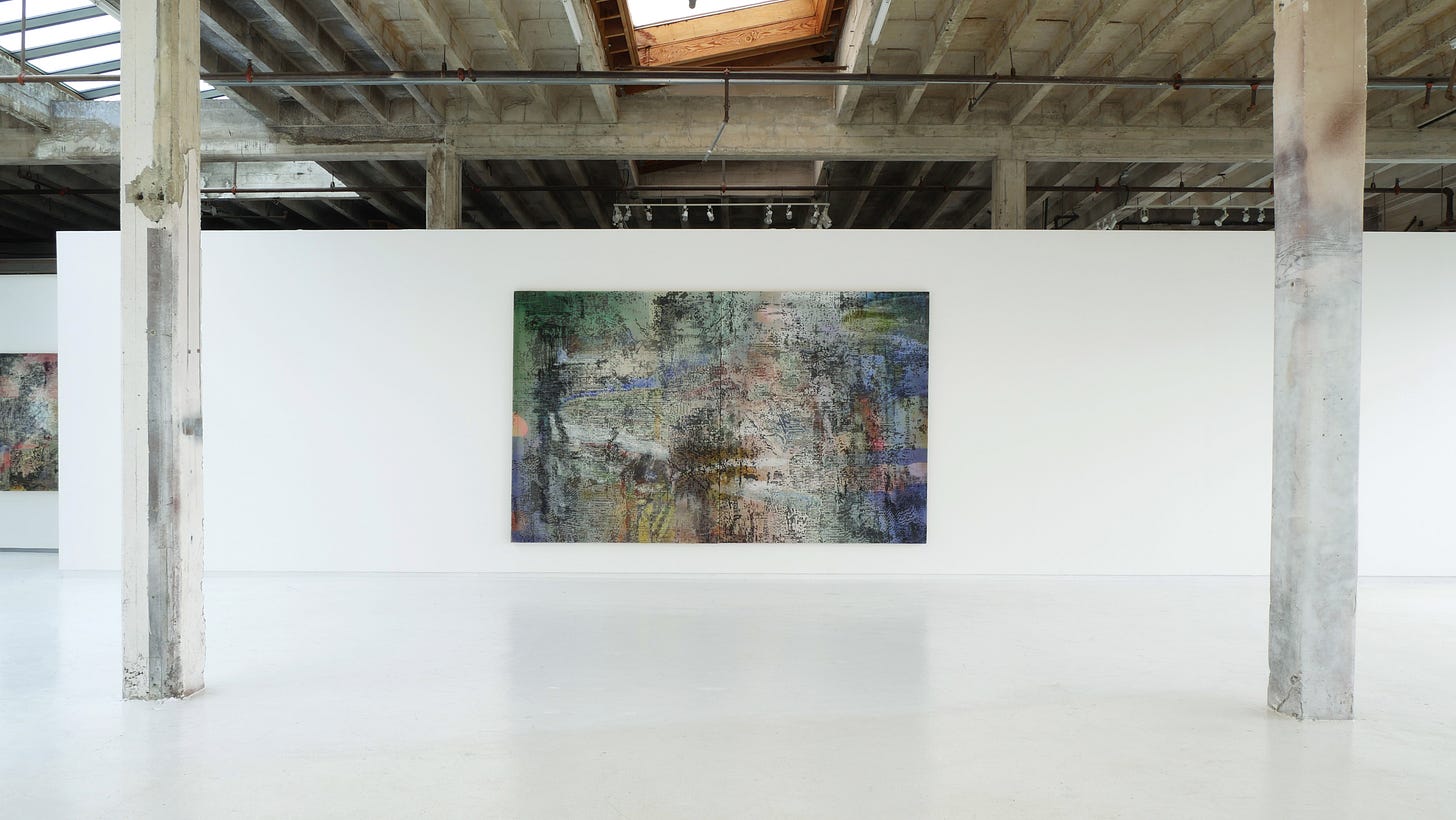
It looks quite layered and textured too. Do you build up layers by this process? How does a piece evolve?
The actual painting process is then a long process in which I work on both sides of the picture plane and consider both to be of equal value for a very long time.
The fabric is dyed before painting, by soaking or spraying or dusting the fabric (depending on which materiality I want to emphasise).
This is followed by the transfer of a drawing - which I usually created digitally beforehand - onto one side of the canvas with a brush. These drawings are then embedded in abstract colour and form, quasi interwoven with the fabric and the color material through the impasto application of paint, which I press from behind through the meshes of the jute.
The picture support functions like a skin, a permeable membrane. Information diffuses from the inside to the outside and influences each other.
I read that you were using jute instead of canvas? How are they different and what do you love about working with jute?
The fiber of the jute is much rawer than that of cotton or linen and the weave is much looser so it’s easier to pull out strings and to manipulate its mesh.
From a distance the paintings look like decayed forms, or chemical reactions that are in a state of growing. What can you say about those interests in relation to your aesthetic?
The surfaces of the paintings are three-dimensional, appearing almost organic like moss or lichen, like something growing and developing, being in constant flux.
The individual colour segments could also be seen as a digitalization of the picture surface or as a view zoomed in on the molecular level of painting, in which the skeleton of the fabric and the individual colour particles become visible.
In any case, the fabric is emphasised - in both a literal and metaphorical sense, the fabric: a compound, an interweaving, a network.
Sometimes there are recognisable forms from nature. How do you balance those elements with the more intuitive painting?
The sources of my drawings come from the micro- and macrocosm. My motifs are microscopic images of plants, digitally altered fingerprints, images of nerve synapses, DNA strands and cell clusters, or structures from the mycorrhiza networks (the underground systems in forests that enable trees and plants to “communicate” with each other and thus survive environmental threats). Other source materials are mathematically or digitally generated optical patterns and codes or satellite images.
I combine all these patterns or structures into abstract, often rhythmic, undulating, proliferating or seemingly exploding formations.
Although they appear to be natural or nature-inspired, there’s also a visible structure. Are you interested in using grids, and is finding some sort of structure important within the piece?
I am emphasising the grid of the jute or the network of the fabric because of my interest in the topic of “interconnectedness” from a biological, social and philosophical point of view, and my preoccupation with the plant and microbiotic world (e.g. fungi) makes me particularly aware of the interconnectedness of all forms of life: both the living dynamics between them and their mutual dependence on each other. I believe that our world is primarily created and constantly reshaped through relationships.
I have a strategy for each individual step in my working process, before I start working, but I can't really control in advance how these actions will cooperate or interact with each other - and what visual phenomena and formations will emerge. In this sense, painting is a very transformative and also humbling experience for me, in which chance or the unexpected plays an important welcome role and I consciously surrender a little to the process and the material.
For me, the fabric and the paint are not objects that I shape, they are subjects with which I interact and communicate.
Lastly, do you have any shows you want to plug?
My new solo show ‘Skin in the Game’ is currently on view at Hosfelt Gallery in San Francisco, which runs from the 2nd of February until March 15th.
Follow Jutta on Instagram: @juttahaeckel
Things on Our Radar This Week
Our friends at The Healthy Artist podcast are back with a great new episode on social media
The bigwigs at Pace Gallery are opening a beautiful new space in Berlin that we can’t wait to visit
The Best Painting Shows in London This Month
Laurence Watchorn Paintings at The Bomb Factory Shoreditch (ends 16 Feb)
Philipp Zollinger at Approach Gallery (ends 15 Feb)
Martin Daiber at Beers London (ends 1 March)
Jemima Moore’s ‘Slipstream’ at Blue Shop Galleries (ends 23 Feb)
Porous Abstraction at Alma Pearl (ends 22 March)
‘On Paper’ at Galerie Max Hetzler ft. Karel Appel, Tal R & more (ends 22 Feb)
The ‘Slab’ group show feat. Kes Richardson at The Bottle Factory (opens 21 Feb)
Thanks for reading, see you next time!
Oliver & Kezia xx
Palette Talk is free and we hope to grow with your support. If you’ve enjoyed reading, drop us a donation via PayPal…




